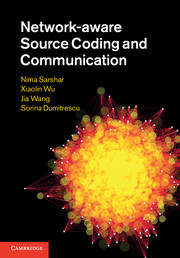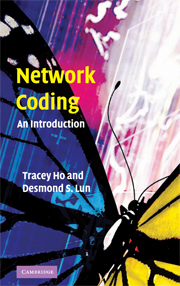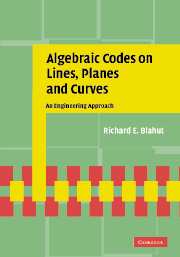Wave Theory of Information
- Author: Massimo Franceschetti, University of California, San Diego
- Date Published: December 2017
- availability: This ISBN is for an eBook version which is distributed on our behalf by a third party.
- format: Adobe eBook Reader
- isbn: 9781108547918
Find out more about Cambridge eBooks
Adobe eBook Reader
Other available formats:
Looking for an inspection copy?
This title is not currently available for inspection. However, if you are interested in the title for your course we can consider offering an inspection copy. To register your interest please contact [email protected] providing details of the course you are teaching.
-
Understand the relationship between information theory and the physics of wave propagation with this expert guide. Balancing fundamental theory with engineering applications, it describes the mechanism and limits for the representation and communication of information using electromagnetic waves. Information-theoretic laws relating functional approximation and quantum uncertainty principles to entropy, capacity, mutual information, rate distortion, and degrees of freedom of band-limited radiation are derived and explained. Both stochastic and deterministic approaches are explored, and applications for sensing and signal reconstruction, wireless communication, and networks of multiple transmitters and receivers are reviewed. With end-of-chapter exercises and suggestions for further reading enabling in-depth understanding of key concepts, it is the ideal resource for researchers and graduate students in electrical engineering, physics and applied mathematics looking for a fresh perspective on classical information theory.
Read more- Relates information-theoretic laws to basic physical principles
- Covers both theory and applications
- Includes end-of-chapter exercises and suggestions for further reading
Reviews & endorsements
'This is an excellent textbook that ties together information theory and wave theory in a very insightful and understandable way. It is of great value and highly recommended for students, researchers and practitioners. Professor Franceschetti brings a highly valuable textbook based on many years of teaching and research.' Charles Elachi, California Institute of Technology and Director Emeritus of the Jet Propulsion Laboratory at NASA
See more reviews'This book is about the physics of information and communication. It could be considered to be an exposition of Shannon information theory, where information is transmitted via electromagnetic waves. Surely Shannon would approve of it.' Sanjoy K. Mitter, Massachusetts Institute of Technology
'Communication and information are inherently physical. Most of the literature, however, abstracts out the physics, treating them as mathematical or engineering disciplines. Although abstractions are necessary in the design of systems, much is lost in understanding the fundamental limits and how these disciplines fit together with the underlying physics. Franceschetti breaks the disciplinary boundaries, presenting communication and information as physical phenomena in a coherent, mathematically sophisticated, and lucid manner.' Abbas El Gamal, Stanford University, California
'This is an ambitious and important book … exceedingly well written, and surprisingly thin, given the amount of material. The mathematics, supplemented by considerable intuitive explanation, is never overwhelming, and should be readily followed by the diligent reader. There are extensive references, and a useful summary at the end of each chapter, along with well-crafted exercises. Unquestionably this book will contribute hugely to [Professor] Franceschetti's goal: 'to break through the compartmentalized walls of several disciplines' … any researcher who purports to work on the advancement of wireless communication theory should take time to study Wave Theory of Information.' Thomas L. Marzetta, IEEE Information Theory Society Newsletter
'Compared to other books, Wave Theory of Information takes a different approach to information theory. It does so by presenting the relationship between information theory and the physics of wave propagation, using electromagnetic waves to describe the representation and communication of information … a textbook for a graduate course in communication and information theory, [it] is intended for PhD students and researchers in electrical engineering.' Edward S. Krebes, The Leading Edge
Customer reviews
Not yet reviewed
Be the first to review
Review was not posted due to profanity
×Product details
- Date Published: December 2017
- format: Adobe eBook Reader
- isbn: 9781108547918
- contains: 174 b/w illus.
- availability: This ISBN is for an eBook version which is distributed on our behalf by a third party.
Table of Contents
1. Introduction
2. Signals
3. Functional approximation
4. Electromagnetic propagation
5. Deterministic representations
6. Stochastic representations
7. Communication technologies
8. The space-wave number domain
9. The time-frequency domain
10. Multiple scattering theory
11. Noise processes
12. Information-theoretic quantities
13. Universal information bounds
Appendix A. Elements of functional analysis
Appendix B. Vector calculus
Appendix C. Methods for the asymptotic evaluation of integrals
Appendix D. Stochastic integration
Appendix E. Special functions
Appendix F. Electromagnetic spectrum
References
Index.
Sorry, this resource is locked
Please register or sign in to request access. If you are having problems accessing these resources please email [email protected]
Register Sign in» Proceed
You are now leaving the Cambridge University Press website. Your eBook purchase and download will be completed by our partner www.ebooks.com. Please see the permission section of the www.ebooks.com catalogue page for details of the print & copy limits on our eBooks.
Continue ×Are you sure you want to delete your account?
This cannot be undone.
Thank you for your feedback which will help us improve our service.
If you requested a response, we will make sure to get back to you shortly.
×






